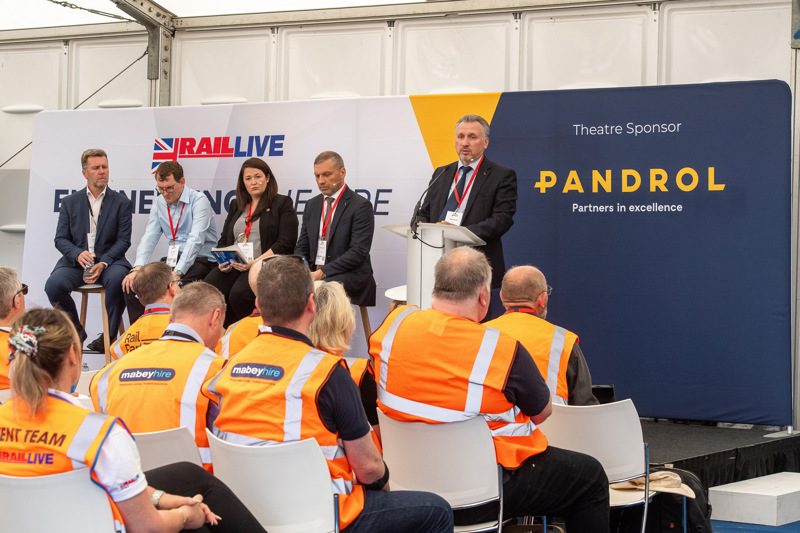The often patchy performance of Britain’s railway network, the General Election and the price of a sandwich at King’s Cross station seem trivial compared with the plight of Ukrainian rail workers risking death every hour in the worst war zones.
They risk their lives from well-targeted missiles and flying bullets, doing their routine (but crucial) jobs in a war zone with hardly any protective clothing.
Around 5,000 people need strong helmets and vests.
You, working with RAIL and industry trade body Rail Partners, can help by contributing to our ‘Kit for Kyiv’ appeal.
While companies can afford much more, even an individual donation of just £20 could literally be the difference between life and death.
It is two and a half years since the invasion of Ukraine by Putin’s Russian forces began, destroying much of its infrastructure.
The state-owned railway Ukrzaliznytsia (UZ) is justly proud that it can still claim 95% on-time figures for its passenger services, even if the schedules are admittedly on the slack side.
Freight (grain and steel are crucial to the economy) is also performing well - again thanks to the wealth of diversionary routes when one becomes damaged.
How UZ is responding to its challenges kept an audience spellbound at our June 19-20 Rail Live event at Porterbrook’s Long Marston Rail Innovation Centre, for which two senior officers flew over specially to recount their experiences of life at war.
Their declaration that the “railway will stand to the last man” generated silent respect.
So did their frank statement that when Ukraine wins the war (there was no question about that), it will continue its programme of investment in brand new trunk routes and rolling stock.
The predominantly British audience, many jaded by decades of political rhetoric and regular policy U-turns, also learned how the Ukrainian government and its people truly loves their railways- something we never seem to have managed in the UK.
Of course, war could never happen here.
None of the parties mentioned that in their manifestos. Nor has Network Rail ever discussed war (why should it?), nor any of the train operators. Train cancellations caused by ‘leaves on the line’ are more pressing matters.
Peace-respecting UZ was probably in the same state of mind until Russia decided on its brutal territorial aggression.
When the conflict started in February 2022, UZ quickly realised that its complex and well-intentioned contingency plans drawn up some years ago were overtaken by events.
It’s a salutary lesson that you can spend time and resources training people for situations that rapidly become irrelevant when a rocket or drone packed with explosives suddenly blows your roof off.
The UZ officials who attended Rail Live and doubtless sampled our railway network were certainly too polite to tell us Brits to get real.
Their focus is on protecting their nation’s 11,000-mile network, which carries two-thirds of the country’s freight (dominated by grain and metals - it is just 7% in the UK), and has 25% of the total passenger business.
UZ is Ukraine’s largest employer with 187,000 paid staff, although some 10,000 are serving in the armed forces.
It is coming to terms with the deaths of over 600 of its people, with many more wounded or incapacitated.
So, what comes first? UZ says it’s the protection of its workforce, which is why RAIL’s appeal is so crucial.
Train crew have already been issued with hard hats and bullet-proof high-visibility vests. But ground staff haven’t - even in the north and east of the country, where the fighting is at its fiercest and workers sometimes find themselves trapped behind enemy lines.

Many new infrastructure projects are obviously on hold because scarce resources have to be channelled into maintaining services, when the invading Russians have rendered a significant number of manufacturing plants useless.
UZ has had to look abroad for basic materials such as replacement rail, which is several times more expensive than the currently unavailable domestic product.
When bridges and buildings are damaged and overhead wires are brought down, emergency repairs are sometimes completed within a few hours, while diversions also allow services to quickly return to something like normal.
Power systems and fuel stores are more of an issue because they are key targets for missiles. But UZ seems to find a solution for everything, such as building replacements underground to increase resilience to attack.
Has anyone over here given that any thought, with HS2 or the newly electrified Midland Main Line and trans-Pennine route?
We doubt it.
When the war is won, UZ wants to push ahead with its master plan for almost 2,000 miles of new standard gauge line on four key routes across the country, to integrate with the European network, and with some 100 new electric locomotives and 90,000 wagons.
Britain’s supply industry will hope to be part of that, and it can if it wins Ukraine’s confidence by helping to ensure its survival as a nation.
Returning to the present, it is gratifying to learn how everyone is pulling together.
This includes the trade unions, who unlike in the UK are not occupied with strikes over pay and conditions.
Instead, they are committed to ‘Protect and Survive’ humanitarian aid by packing up and distributing food parcels.
Like everyone else, they recognise that Ukraine is entirely reliant on world financial aid that will eventually run into the high billions - currently for military deployment, but later to plan and execute national rehabilitation.
We all hope this will come soon.
Thousands of parcels of essential goods have been delivered to Ukrainian Railway workers and their families, paid for by donations from British railway companies.
But now UZ needs our help to protect its workers.
Let’s pull together once again.
How to support Kit for Kyiv!
- Make donations and for more information on the initiative
- For industry colleagues, to find out more about how you can support colleagues at Ukrainian Railways, contact [email protected]
- View a list of corporate donors and to find out more about Rail Partners with Ukraine and #KitForKyiv
- Kit for Kyiv is being run in conjunction with the international Global Ukraine Rail Task Force, with all donations in Sterling going directly into the campaign.














Login to comment
Comments
No comments have been made yet.